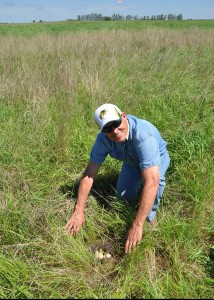by Dan Janes, Communications Coordinator and GIS Management Analyst, North Dakota Farm Service Agency

Bruce Pantzke’s CRP enhanced with pollinator habitat also provides vital nesting cover for both upland game and waterfowl.
When most people think of pollinator habitat, they think of bees and butterflies. Bruce Pantzke is thinking of pheasants. “The diversity of plants in a pollinator mix attracts a lot of beneficial insects, which in turn provides a great food source for pheasant chicks, and it provides great nesting habitat,” Pantzke said.
Pantzke first heard about the benefits of pollinator habitats through Pheasants Forever at the annual Pheasant Fest meeting. When he offered land on his farm near Fort Ransom, North Dakota, under a general Conservation Reserve Program (CRP) signup, he opted to enhance the offered acres with pollinator habitat to improve the Environmental Benefits Index (EBI) that Farm Service Agency (FSA) uses to rank the land, increasing the chance that his offer would be accepted.
Once the CRP offer was accepted, Pantzke enlisted the help of Susan Muske, district manager for the LaMoure County Soil Conservation District to get the pollinator habitat established. “It takes a lot of effort, and a lot of time, but it’s definitely worth it. And Bruce has been very devoted to making this work,” Muske said. “Patience is really important, because it can take two or three, even five years for some of these plants to become established.”
One of the challenges Pantzke has faced has been eliminating introduced brome grasses and getting native grasses and wildflowers to take hold. Pantzke said that good seedbed preparation is key. “Weed control can be a challenge, but you have to change how you think about weeds and realize that as long as they are not getting out of hand, they’re part of the diversity. After all, you don’t want to kill the good with the bad.”
Seed heads from last year’s purple coneflower dot a 30-acre field that was part of Pantzke’s CRP offer. Later in the summer, the field will be covered with blanketflower, providing a great benefit to the honeybees flying from hives located across the gravel road. “I don’t doubt that those hives are located there because of this field,” Pantzke said. Shortly after pointing out the hives, a blue-winged teal bursts from the grass, revealing a clutch of 8 eggs.
“It’s a domino effect,” Muske said, referring to the diverse wildlife utilizing the pollinator habitats that Pantzke has established. As the diversity of the plant community increases, a wider range of animals are able to make use of the land, from songbirds and upland game to waterfowl and large mammals like white-tailed deer.
http://lamoure.nd.nacdnet.org/
http://www.fsa.usda.gov/CRPis30





